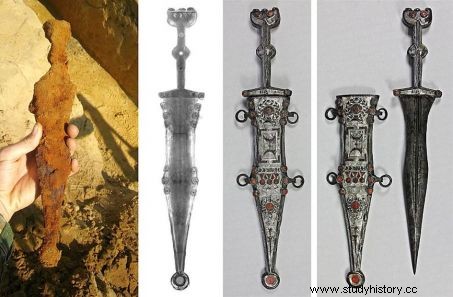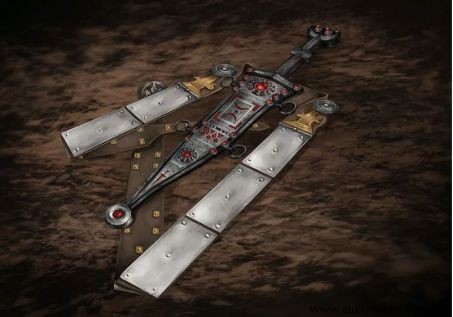It is the weapon of a Roman legionnaire who fought the Germanic tribes on the imperial limes, at the border of the empire, 2000 years ago. It was found in an exceptional state of preservation. Restored, this dagger was unveiled for the first time to the public.

2000 years old, the Roman dagger from Haltern am See after its restoration.
Is it such a blade that will have killed Caesar? A remarkable dagger, discovered in the spring of 2019 near the city of Münster (Germany), has just been presented to the Kunst und Kultur museum of Haltern. Strikingly preserved, the blade and its chiseled case, decorated with foliage in silver and brass threads, have spent 2000 years wrapped in a matrix of earth. Before being unearthed by Nico Calmund, 19, during an archaeological dig carried out in the Roman cemetery of Haltern am See in cooperation with the University of Trier. "Never has a Roman dagger of such quality reached us “, enthuses historian Yann Le Bohec, professor emeritus at La Sorbonne, in Paris, specialist in Roman warfare, joined by Sciences et Avenir .

In the LWL lab, the dagger after restoration. © LWL / C. Steimer
"There is no doubt that this is one of the greatest discoveries of its kind made in Europe "
The restoration of this 30 cm weapon – called pugio by the legionnaires - lasted nine months in the LWL workshop in Münster. It was slipped into a sheath encrusted with enamel and shards of red glass and attached to a belt made of an assembly of bronze and brass plates covered with tin. "This set has no comparison at this time .There is no doubt that this is one of the greatest discoveries of its kind made in Europe “, explained for his part Michael Rind, the archaeologist responsible for the Westphalia-Lippe region, to the British daily Times.
The dagger and belt underwent X-rays and computer-assisted tomographic examination before restoration. They revealed that the blade of the dagger was made of different steels and showed signs of wear. "Which shows that it was not just a ceremonial dagger, although it has many aspects of it. Its owner used it “, continued Yann Le Bohec.

The "pugio" at the time of its discovery, during x-rays, and finally restored. © LWL / Josef Mühlenbrock
The dagger, used to finish off enemies or kill too many prisoners
According to specialists, based on the narrow shape of the blade and its structure, this weapon can be equated with the first Roman military daggers of the type Vindonissa ( named after a Roman camp located in Switzerland where they were found) . They were used mainly during the first half of the 1st century AD. JC, "but not during combat" , says the expert, who continues:"Roman infantry indeed fought using several weapons. A large shield in the left hand, held either by a hilt or attached to the forearm. And a spear (pilum) in the right hand. Advancing in lines, when he approached within 3 or 4 m of the enemy, the legionnaire threw the javelin about 1.80 m long to pierce him . Then he threw himself on another fighter, drawing his sword ( gladius) after hitting him with a shield to knock him off balance and kill him on the move. All this while running, which required a lot of training. The dagger, worn on the left along the body, was only used to finish off enemies or too many prisoners... or even the wounded of one's own side when nothing more could be done for them".

Graphic reconstruction of the belt dagger set. © Elif Siebenpfeiffer
Texts also indicate that such daggers were used for political assassinations in Rome. The Haltern site where the weapon was found was an important military camp that had to be abandoned following the Teutoburg disaster in Westphalia, Rome's most famous defeat. Three Roman legions and their auxiliary troops (25,000 men) had been wiped out there in AD 9, when the armies of General Publius Quinctilius Varus were crushed by a powerful coalition of Germanic peoples led by Arminius. The ornate dagger will be on display at the Roman History Museum in Haltern in 2022.
